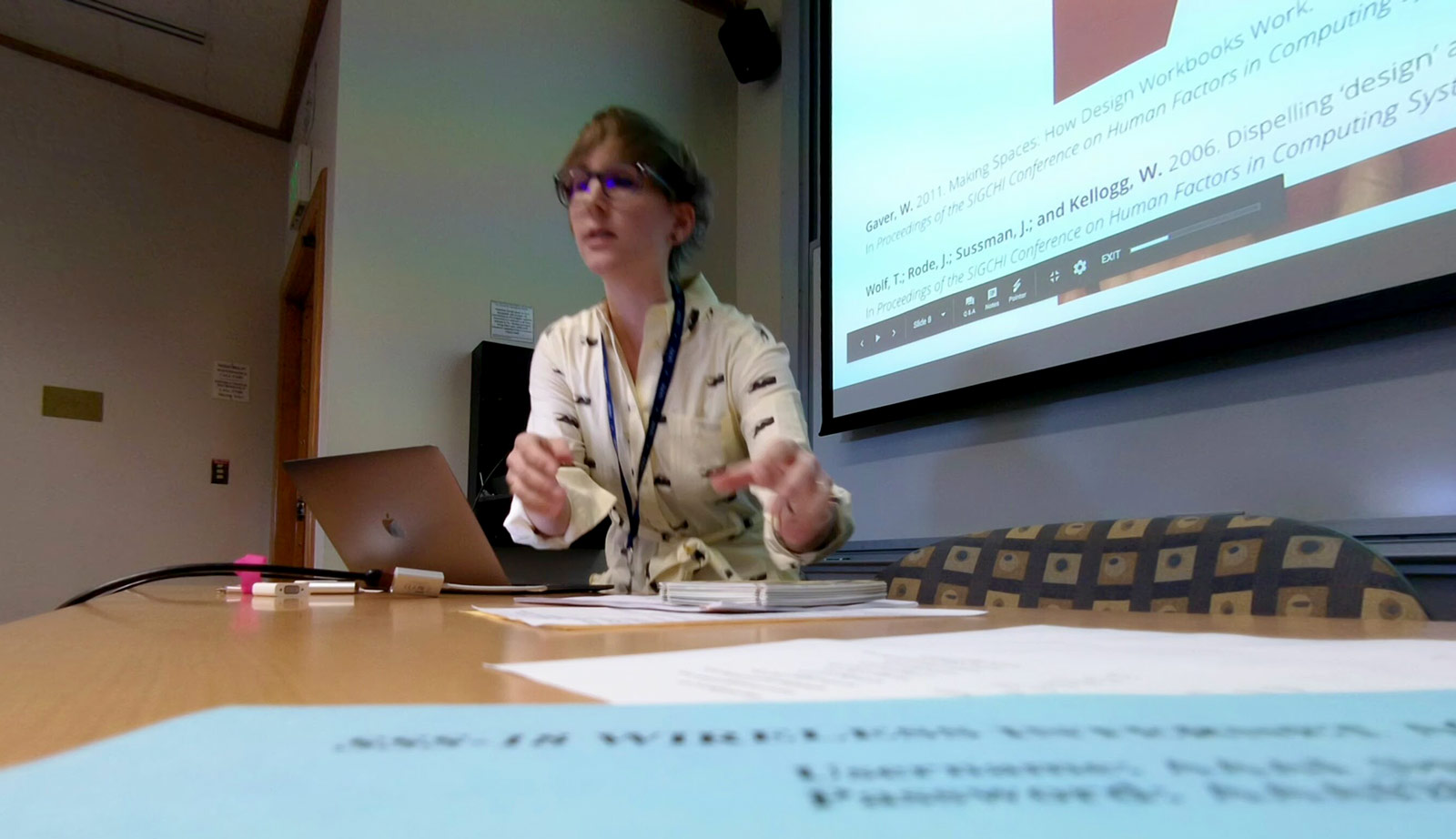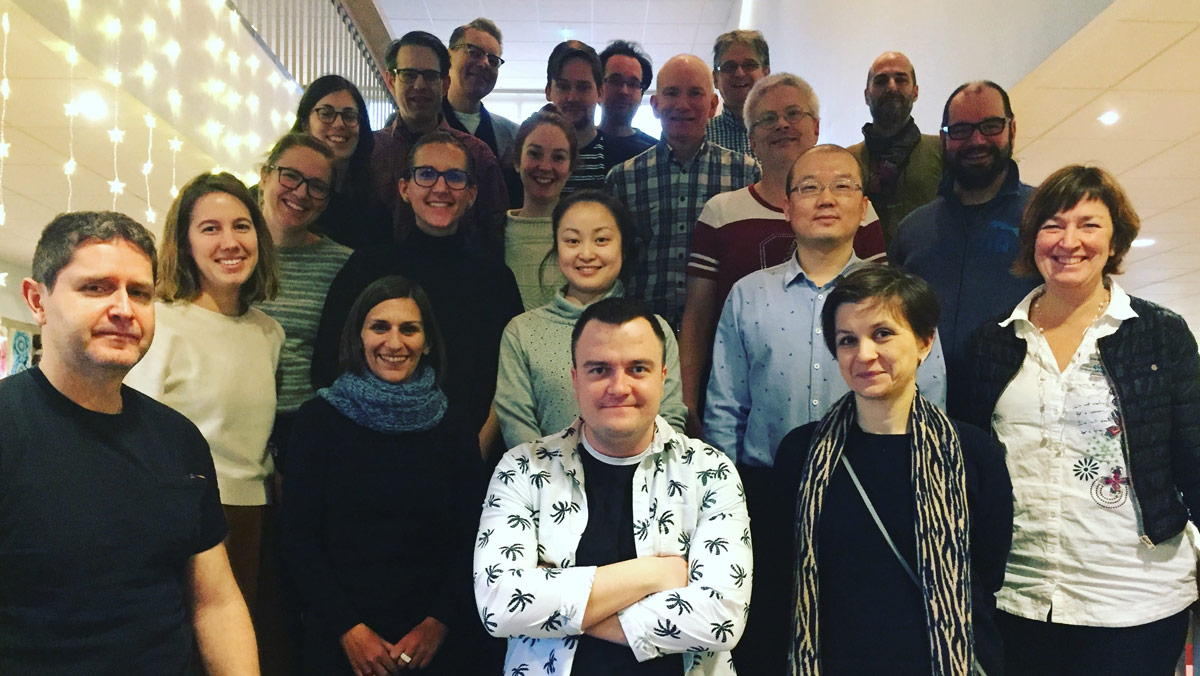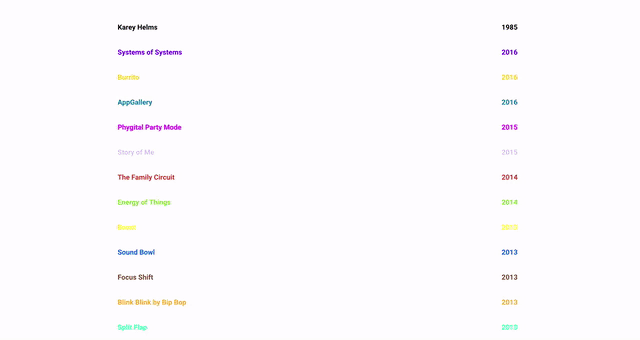Category: Physical Computing
Design Briefs – Spying on Loved Ones & Tangible Designs for Effort, Exertion, and Exhaustion
For this year’s Advanced Project Course in Interaction Design at KTH, I’m fortunate and excited to have two groups of second-year master’s students working with me on two project briefs – Spying on Loved Ones and Tangible Designs for Effort, Exertion, and Exhaustion during Outdoor Experiences. Excited to see their resulting design work in December!
Spying on Loved Ones
To spy on someone is commonly thought of as a negative or harmful act during which one person secretly observes or collects information on another for malicious purposes. Yet, we also “spy” for many positive reasons. For example, these might include watching a sleeping child through a baby monitor, checking a partner’s calendar to plan a surprise birthday party, or browsing the fridge of an elderly parent to ensure a healthy diet is being consumed. What these examples have in common is that they are acts of care. This projects investigates how we care for others through technology, both with technologies explicitly designed to survey or observe others and through technologies designed for other purposes yet leak implicit information that enables spying. Within this investigation, various forms of spying will be classified and critiqued, the social and cultural implications of these positive intentions with be explored, and speculative prototypes will be designed to either further enable or inhibit spying.
The project will follow the suggested steps: (1) a review and critique of technologies explicitly designed for spying in private and public spaces, (2) investigation into ways in which people spy on others through technologies not designed for spying, possibly through workshops, interviews, or cultural probes, (3) the design of speculative prototypes to either further enable or inhibit spying, resulting in an ecology of physical artifacts. Required skills include strong design sensibilities and an interest in critical design and design fiction.
This project builds upon Leaky Objects: Implicit Information, Unintentional Communication.
Tangible Designs for Effort, Exertion, and Exhaustion during Outdoor Experiences
Multi-day outdoor activities such as hiking, skiing, cycling, and horseback riding involve full body engagement, during which bodies become sore and often endure physical transformations. Yet despite perceived discomfort and difficulties, outdoors experiences are often considered rewarding and relaxing. Thus, rather than designing to make these activities easier or more comfortable, this project investigates designing tangible artifacts and devices to celebrate or enhance these experiences of effort, exertion, and exhaustion. This project is part of a broader, ongoing outdoors project within the Smart Implicit Interaction project, and has the opportunity to build upon recent interviews with participants who have engaged in long-term outdoors experiences.
The outcome of the project is open-ended, but students are expected to engage in a design process to that result in novel artifacts that are either proposed objects of use (e.g. products) or result in interesting new learnings (e.g. cultural probes). Students should have a design background or be interested in following a design process.
AAAI 2018 – Presentation & Slides

Last week I presented my paper Design Methods to Investigate User Experiences of Artificial Intelligence at the 2018 AAAI Spring Symposium on the User Experiences of Artificial Intelligence. The picture above was taken by a Google Clips camera, which was also one of the presented papers. Below are my slides, which contain supplementary images to my paper on the three design methods I have engaged with relative to the UX of AI. Another blog post will soon follow with reflections on other papers presented.
PhD’ing – Writers’ Retreat, Project Offsite, Outdoors Research, and Making Preciousness
Today I saw a meme on Instagram which said, “We are now entering the third month of January.” I couldn’t relate more! And looking back over the past few weeks, cannot believe all that has already happened in 2018.

Writer’s Retreat
Following a paper deadline in early January, my department at KTH (Media Technology and Interaction Design) kicked off 2018 with a writers’ retreat. What happens at a writers’ retreat? We book a venue in the Stockholm archipelago for three days and two nights, and write. And sauna and winter swim, but mainly write. The primary purpose of the retreat is to provide time and space away from everyday academic duties, from teaching to admin responsibilities, in order to focus on increasing the quality and quantity of our writing output. During the three days, we follow an agile framework in which junior/senior pairs write in ~45 minute sprints and then provide ~15 minutes of feedback. In addition to intense writing blocks, lunches, dinners, and evening activities provide ample opportunities to better know our colleagues professionally and personally. Though equally as exhausting as the writing, this social time I find incredibly valuable in creating a continued collaborative culture at work.
During this year’s writing camp I started a paper on a Pee-ometer, a recent project by Master’s students that I proposed and supervised in which they prototyped a wearable device that predicts when a user has to pee to investigate Machine Learning as a design material.
Project Offsite
In mid January, the Smart Implicit Interaction project had a two day project offsite. As the project is composed of differing philosophical and methodological backgrounds – i.e. Artificial Intelligence, Social Sciences, and Interaction Design – the first day consisted of a beginners overview into reinforcement and representational learning in neural networks to introduce technical terminology and objectives. During the second day, all of the sub-projects presented their current status and goals for the year. I specifically presented two ongoing design projects, data-driven design methods and the Pee-ometer. In the former, I discussed early design activities and resulting concepts from investigating the implications of screenshots as a data source. In the latter, I discussed three high-level interests guiding future project directions, including Machine Learning as a design material, interactional loops, and critique and ethics. Overall, it was inspiring to share and strategize better collaborations while revisiting overarching project objectives.
Project Offsite
Last week continued January’s streak of out-of-office research activities and into the forest. To kick off an new outdoors project, myself and three senior researchers went on a mid-week day hike 30 minutes outside of Stockholm. Not only was I surprised at a Professor’s ability to make a fire in the snow, but the excursion was both refreshing and constructive. More in the coming months!
Making Preciousness
And last but definitely not least, friend and fellow PhD student Vasiliki successfully defended her thesis Making Preciousness: Interaction Design Through Studio Crafts. Her opponent Ron Wakkary gave a much deserved brilliant presentation of her work before lengthy discussions with him and the committee. Admittedly, it is selfishly bittersweet to see her finishing as she has been a tremendous support and inspiration during the first year of my own PhD.
MeetUp – Artificial Intelligence, Machine Learning & Bots
Back in June I attended Practical Introduction into Artificial Intelligence by ASI Data Science as part of London Technology Week. The event was very well structured, and more importantly, perfectly distilled complex theories and processes into a digestible format for a novice like myself. I left feeling like an expert, and was able to confidently re-articulate the evening to others, which I think is very much a sign of a well run event and of course, great instructors. Moreover, as I’m navigating the world of artificial intelligence and machine learning in relation to my role and interests as an Interaction Designer, I’m being intentionally thoughtful regarding the Pareto Principle – I don’t actually need to be an expert, but do want a solid 20% foundational knowledge base.
Anyhow, the evening began with a history of artificial intelligence and the corresponding theories of influential scientists on the topic before launching into a hands-on session in which participants built our own handwriting recognition engine. Key takeaways included a clearer understanding of the relationship between artificial intelligence verse machine learning, a new comprehension of artificial neural networks (see slide below), and insights into what is and is not currently possible relative to real world applications.

Fast forward to this past Tuesday, when I attended a MeetUp by Udacity at Google Campus London on Machine Learning and Bots by Lilian Kasem. Very different content and structure but equally insightful. Lilian’s talk was centered around Bots specifically – from the definition of a bot, to a live coding demo of the creation of a bot in Microsoft Bot Framework, and best bot practices – all while weaving in the integration of machine learning if it adds value (I also appreciate her stress on the if). Her resources in the image below:

In addition to the obvious relevance of these two events to current interaction design trends, they are helping me formulate next steps for two of my current projects, one personal and one professional.
The personal project – Burrito, a marriage bot that analyzes messages between my husband and me to determine who is a better spouse – is currently being refactored into a formal bot for Telegram. Lilian’s talk in particular was very helpful as my project focus as transitioned from theoretical to technical as I am now seeking to create a higher fidelity product and implement better, if not best, programming practices.
The professional project, for which I will intentionally be quite vague, investigates the impact of implicit data on enterprise organizational and technical systems, and in particular, the transition from frictionless to exception based workflows. As an Interaction Designer, I firmly believe it is important to not only empathize with humans, but also technology and its corresponding data because the concept of user – who, what, or where – is increasingly being blurred. Therefore, ASI’s introduction into AI was particular helpful in how I understand, design for, and implement data into my professional practice.
Long story short – two great events! In the coming weeks, I am to write a followup post regarding my technical developments in regards to Burrito bot, but also an online course I began this week to formalize my programming skills relative the Internet of Things.
Updated Portfolio in Google Polymer
This past week I finally finished refactoring my interaction design portfolio using Google Polymer in addition to adding new projects (Systems of Systems, Burrito, Phygital Party Mode, and Story of Me). Still much work to be continued, including incorporating page routing, improving performance and load time, and better code practices. I’m new to Polymer, thus much to learn.

The reason I’ve decided to use Polymer is the ease at which I can use Firebase. Essentially, though currently disabled as I continue refactoring, I have a portfolio mode called Phygital Party Mode, whereby by when a portfolio visitor clicks this mode, the colors seen in the above GIF are reflected in a Philips Hue light in my London flat. I also think it is a relevant, modern tool to learn independent of my portfolio.